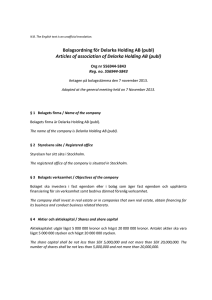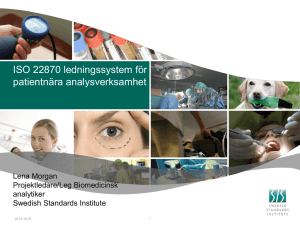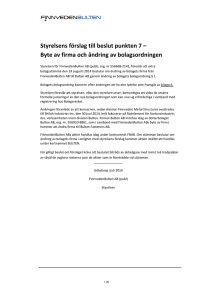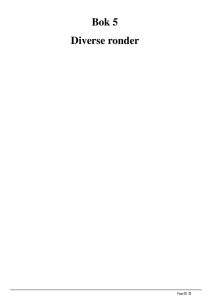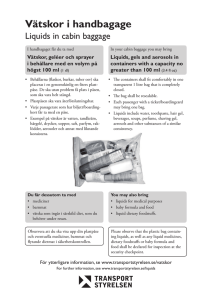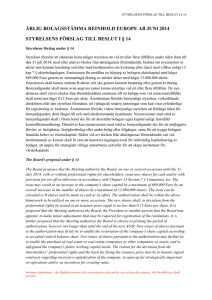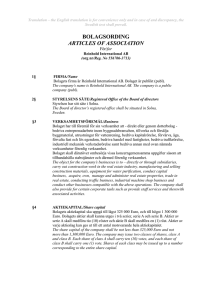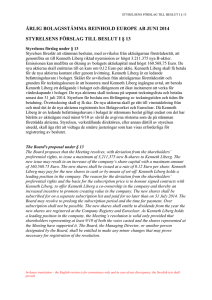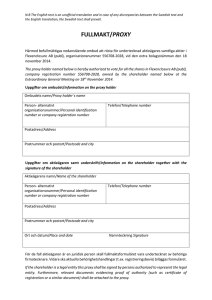Revision av ISO 15189
advertisement
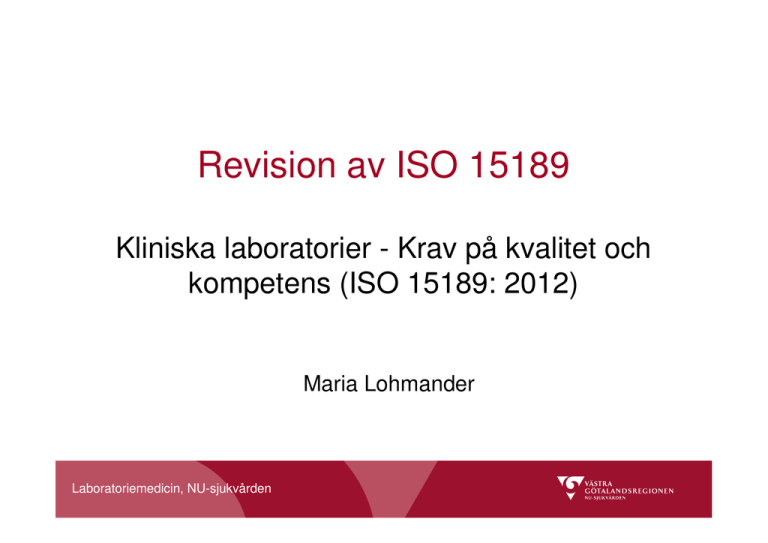
Revision av ISO 15189 Kliniska laboratorier - Krav på kvalitet och kompetens (ISO 15189: 2012) Maria Lohmander Laboratoriemedicin, NU-sjukvården Vilka har arbetat med revisionen? ● Nationella och internationella möten och arbetsgrupper ● I Sverige: TK331 – Teknisk kommitté för Laboratoriemedicin − Myndigheter − Företag − Landstingsrepresentanter Laboratoriemedicin, NU-sjukvården Kort historik ● Processen har pågått sedan 2007 då ett första förslag skickades ut. Röstades ned. ● Enkät skickades ut och svaren bearbetades under 2008-2009 ● Nytt förslag under 2010 ● Det nya förslaget har bearbetats och efter flera turer och omröstningar publicerades den nya versionen i november 2012 Laboratoriemedicin, NU-sjukvården Nya versionen ● Mer lättläst – uppdelad i fler paragrafer ● Mer omfattande och mer detaljrik (36 sidor jmfr med 23 i den tidigare) ● Mer fokus på personalens kompetens (Tidigare Bilaga C med etiska krav infört förkortat) ● Mer fokus på kunden ● Något mer processinriktad och viss koppling till IVD ● Tydligare krav på dokumentation ● Tidigare Appendix med IT-krav infört i standarden Laboratoriemedicin, NU-sjukvården Mer omfattande 15189: 2007 Laboratoriemedicin, NU-sjukvården 15189: 2012 Kvalitetsindikatorer 4.12.4 Laboratory management shall implement quality indicators for systematically monitoring and evaluating the laboratory’s contribution to patient care. When this programme identifies opportunities for improvement, laboratory management shall address them regardless of where they occur. Laboratory management shall ensure that the medical laboratory participates in quality improvement activities that deal with relevant areas and outcomes of patient care. 4.14.7 Quality indicators The laboratory shall establish quality indicators to monitor and evaluate performance throughout critical aspects of pre-examination, examination and post-examination processes. EXAMPLE Number of unacceptable samples, number of errors at registration and/or accession, number o f corrected reports. The process of monitoring quality indicators shall be planned, which includes establishing the objectives, methodology, interpretation, limits, action plan and duration of measurement. The indicators shall be periodically reviewed, to ensure their continued appropriateness. NOTE 1 Quality indicators to monitor non-examination procedures, such as laboratory safety and environment, completeness of equipment and personnel records, and effectiveness of the document control system may provide valuable management insights. NOTE 2 The laboratory should establish quality indicators for systematically monitoring and evaluating the laboratory’s contribution to patient care (see 4.12). The laboratory, in consultation with the users, shall establish turnaround times for each of its examinations that reflect clinical needs. The laboratory shall periodically evaluate whether or not it is meeting the established turnaround times. Laboratoriemedicin, NU-sjukvården Utbildning Annex C (informative) Ethics in laboratory medicine 5.1.5 Training The laboratory shall provide training for all personnel which includes the following areas: a) the quality management system; b) assigned work processes and procedures; c) the applicable laboratory information system; d) health and safety, including the prevention or containment of the effects of adverse incidents; e) ethics; f) confidentiality of patient information. Personnel that are undergoing training shall be supervised at all times. The effectiveness of the training programme shall be periodically reviewed. Laboratoriemedicin, NU-sjukvården Exempel på detaljnivå 5.1.6 Personnel shall have training specific to quality assurance and quality management for services offered. 5.1.6 Competence assessment Following appropriate training, the laboratory shall assess the competence of each person to perform assigned managerial or technical tasks according to established criteria. Reassessment shall take place at regular intervals. Retraining shall occur when necessary. NOTE 1 Competence of laboratory staff can be assessed by using any combination or all of the following approaches under the same conditions as the general working environment: a) direct observation of routine work processes and procedures, including all applicable safety practices; b) direct observation of equipment maintenance and function checks; c) monitoring the recording and reporting of examination results; d) review of work records; e) assessment of problem solving skills; f) examination of specially provided samples, such as previously examined samples, interlaboratory comparison materials, or split samples. NOTE 2 Competency assessment for professional judgment should be designed as specific and fit for purpose. Laboratoriemedicin, NU-sjukvården 5.1.9 There shall be a continuing education programme available to staff at all levels. 5.1.9 Personnel records Records of the relevant educational and professional qualifications, training and experience, and assessments of competence of all personnel shall be maintained. These records shall be readily available to relevant personnel and shall include but not be limited to: a) educational and professional qualifications; b) copy of certification or license, when applicable; c) previous work experience; d) job descriptions; e) introduction of new staff to the laboratory environment; f) training in current job tasks; g) competency assessments; h) records of continuing education and achievements; i) reviews of staff performance; j) reports of accidents and exposure to occupational hazards; k) immunisation status, when relevant to assigned duties. NOTE The records listed above are not required to be stored in the laboratory, but can be maintained in other specified locations, providing they remain accessible as needed. Laboratoriemedicin, NU-sjukvården Personalutrymmen - saknar motsvarighet i den äldre versionen 5.2.4 Staff facilities There shall be adequate access to washrooms, to a supply of drinking water and to facilities for storage of personal protective equipment and clothing. NOTE When possible, the laboratory should provide space for staff activities such as meetings and quiet study and a rest area. Laboratoriemedicin, NU-sjukvården Reagens och förbrukningsmaterial acceptansprovning - saknar motsvarighet i den äldre versionen 5.3.2.3 Reagents and consumables — Acceptance testing Each new formulation of examination kits with changes in reagents or procedure, or a new lot or shipment, shall be verified for performance before use in examinations. Consumables that can affect the quality of examinations shall be verified for performance before use in examinations. Laboratoriemedicin, NU-sjukvården Tydligare krav på information tillgänglig för kunden 5.4.2 Specific instructions for the proper collection and handling of primary samples shall be documented and implemented by laboratory management (see 4.2.4) and made available to those responsible for primary sample collection. These instructions shall be contained in a primary sample collection manual. 5.4.2 Information for patients and users The laboratory shall have information available for patients and users of the laboratory services. The information shall include as appropriate: b) types of clinical services offered by the laboratory including examinations referred to other laboratories; d) the examinations offered by the laboratory including, as appropriate, information concerning samples required, primary sample volumes, special precautions, turnaround time, (which may also be provided in general categories or for groups of examinations), biological reference intervals, and clinical decision values; etc. Laboratoriemedicin, NU-sjukvården Provtagningsanvisningar - saknar motsvarighet i den äldre versionen 5.4.4.3 Instructions for collection activities The laboratory’s instructions for collection activities shall include the following: a) determination of the identity of the patient from whom a primary sample is collected; b) verification that the patient meets pre-examination requirements [e.g. fasting status, medication status (time of last dose, cessation), sample collection at predetermined time or time intervals, etc.]; etc. Laboratoriemedicin, NU-sjukvården Koppling till IVD - saknar motsvarighet i den äldre versionen 5.5.1.2 Verification of examination procedures Validated examination procedures used without modification shall be subject to independent verification by the laboratory before being introduced into routine use. The laboratory shall obtain information from the manufacturer/method developer for confirming the performance characteristics of the procedure. The independent verification by the laboratory shall confirm, through obtaining objective evidence (in the form of performance characteristics) that the performance claims for the examination procedure have been met. The performance claims for the examination procedure confirmed during the verification process shall be those relevant to the intended use of the examination results. The laboratory shall document the procedure used for the verification and record the results obtained. Staff with the appropriate authority shall review the verification results and record the review. Laboratoriemedicin, NU-sjukvården Mätosäkerhet 5.5.1.4 Measurement uncertainty of measured quantity values The laboratory shall determine measurement uncertainty for each measurement procedure in the examination phase used to report measured quantity values on patients’ samples. The laboratory shall define the performance requirements for the measurement uncertainty of each measurement procedure and regularly review estimates of measurement uncertainty. NOTE 2 Measurement uncertainties may be calculated using quantity values obtained by the measurement of quality control materials under intermediate precision conditions that include as many routine changes as reasonably possible in the standard operation of a measurement procedure, e.g. changes of reagent and calibrator batches, different operators, scheduled instrument maintenance. The laboratory shall consider measurement uncertainty when interpreting measured quantity values. Upon request, the laboratory shall make its estimates of measurement uncertainty available to laboratory users. Where examinations include a measurement step but do not report a measured quantity value, the laboratory should calculate the uncertainty of the measurement step where it has utility in assessing the reliability of the examination procedure or has influence on the reported result. Laboratoriemedicin, NU-sjukvården Biologiska referensintervall eller kliniska beslutsvärden – kravet på periodisk granskning borta 5.5.5 Biological reference intervals shall be periodically reviewed. If the laboratory has reason to believe that a particular interval is no longer appropriate for the reference population, then an investigation shall be undertaken, followed, if necessary, by corrective action. A review of biological reference intervals shall also take place when the laboratory changes an examination procedure or pre-examination procedure, if appropriate. 5.5.2 Biological reference intervals or clinical decision values The laboratory shall define the biological reference intervals or clinical decision values, document the basis for the reference intervals or decision values and communicate this information to users. When a particular biological reference interval or decision value is no longer relevant for the population served, appropriate changes shall be made and communicated to the users. When the laboratory changes an examination procedure or pre-examination procedure, the laboratory shall review associated reference intervals and clinical decision values, as applicable. Laboratoriemedicin, NU-sjukvården Automatiserat val och rapportering av resultat - saknar motsvarighet i den äldre versionen 5.9.2 Automated selection and reporting of results If the laboratory implements a system for automated selection and reporting of results, it shall establish a documented procedure to ensure that: a) the criteria for automated selection and reporting are defined, approved, readily available and understood by the staff; NOTE Items for consideration when implementing automated selection and reporting include changes from previous patient values that require review and values that require intervention by laboratory personnel, such as absurd, unlikely or critical values. b) the criteria are validated for proper functioning before use and verified after changes to the system that might affect their functioning; c) there is a process for indicating the presence of sample interferences (e.g. haemolysis, icterus, lipaemia) that may alter the results of the examination; d) there is a process for incorporating analytical warning messages from the instruments into the automated selection and reporting criteria, when appropriate; e) results selected for automated reporting shall be identifiable at the time of review before release and include date and time of selection; f) there is a process for rapid suspension of automated selection and reporting. Laboratoriemedicin, NU-sjukvården Nytt kapitel som berör LIS 5.10 Laboratory information management Laboratoriemedicin, NU-sjukvården Sammanfattning Inte så detaljerad som först befarades Bra i många delar – förtydliganden Mer fokus på kund – pre-analys, TAT, kvalitetsindikatorer m.m. Mer fokus på personalens kompetens – dokumentation, etik m.m. ● Nytt om autovalidering ● Nytt kapitel som berör LIS ● Saknas krav på periodisk granskning av referensvärden ● ● ● ● Laboratoriemedicin, NU-sjukvården Framtiden • Standarden publicerades i november 2012 • Svensk översättning är på gång – ev. klar senare i vår • Övergångsperioden från den gamla versionen ser ut att bli 3 år • Fritt fram för laboratorierna att anta den – SWEDAC kan teoretiskt sett bedöma efter den redan nu Laboratoriemedicin, NU-sjukvården Tack för uppmärksamheten! Laboratoriemedicin, NU-sjukvården
